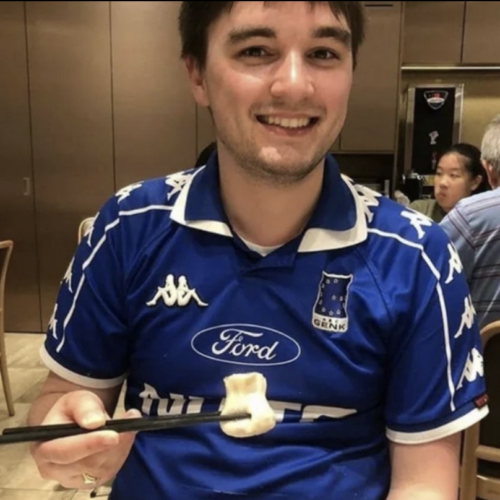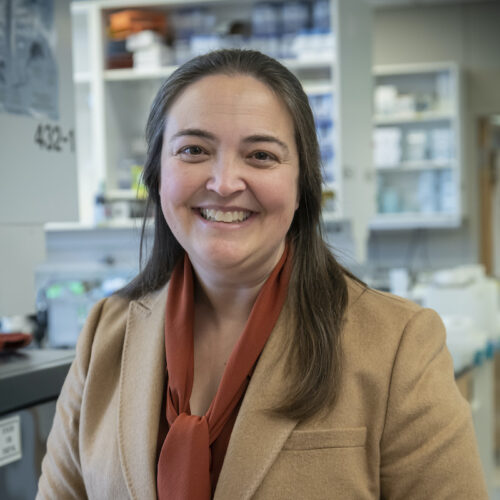INTERCEPTING OVARIAN CANCER
High-grade serous ovarian carcinoma (HGSOC) is a highly aggressive gynecologic cancer and the fifth most common cause of cancer-related death for women in the United States. Unfortunately, most women are diagnosed with late-stage disease, and the prognosis in these cases is poor.
High-grade serous ovarian carcinoma (HGSOC) is a highly aggressive gynecologic cancer and the fifth most common cause of cancer-related death for women in the United States. Unfortunately, most women are diagnosed with late-stage disease, and the prognosis in these cases is poor.
PROJECT HIGHLIGHTS
- Recent research has shown that most, if not all, high-grade serous ovarian cancer originates as precursor lesions of the fallopian tubes. This presents an opportunity to reduce ovarian cancer incidence by exploring the impact of fallopian tube removal as a primary prevention strategy (known as opportunistic or prophylactic salpingectomy).
- The team will develop strategies to expand awareness of and access to safe and effective ways for women to undergo opportunistic salpingectomy, particularly in women who are done having children and already undergoing elective abdominal surgeries.
- The team will create new cross-specialty collaboration between gynecologic and general surgeons, advocate for universal health insurance coverage for opportunistic salpingectomy and create a national registry of women who elect this preventative intervention.
- The culmination of the project will be a public health campaign to empower women to know about and to have opportunity to decrease their risk of ovarian cancer.
- At the same time, the Intercepting Ovarian Cancer team will work together to create an ovarian “pre-cancer atlas” by conducting exhaustive molecular analyses on many rare, precancerous fallopian tube lesions obtained from all 4 participating cancer centers.
- The team will identify new biomarkers that can be used to advance ovarian cancer screening and new, cutting-edge technologies for detecting and analyzing pre-cancers, including “OvaSeek”, a system that will rapidly image excised fallopian tubes and the “iCollector” to nondestructively harvest living cells from fallopian tube lesions.
TEAMLAB UPDATES






MEET THE TEAM

Alan D’Andrea, MD

Andrew McPherson, PhD

Angela Belcher, PhD

Bert Vandereydt, MS

Britta Weigelt, PhD

David Kolin, MD, PhD

Duaa Al-Rawi, MD, PhD

Ie-Ming Shih, MD, PhD

Jianzhu Chen

Kara Long, MD, MSc

Kathleen H. Burns, MD, PhD

Kripa K. Varanasi, PhD

Larissa Meyer, MD, MPH

Linghua Wang, MD, PhD

Melanie Weigert, PhD

Narmen Azazmeh, PhD

Neelkanth (Neel) Bardhan, PhD

Nickolas Papadopoulos, PhD

Rameen Beroukhim, MD, PhD

Rebecca Stone, MD

Shannon N. Westin, MD, MPH

Shengnan Huang, PhD

Siri Palreddy

Sohrab Shah, PhD

Thomas Bauer, MBA, RT(R)

Thomas R. Pisanic II, PhD

Tian-Li Wang, PhD

Alan D’Andrea, MD
Dana-Farber Cancer Institute
TeamLabs: Intercepting Ovarian Cancer and Targeting Minimal Residual Disease in Ovarian Cancer
Dr. D’Andrea received his Doctor of Medicine from Harvard Medical School in 1983. He completed his residency at the Children’s Hospital of Philadelphia, and a fellowship in pediatric hematology-oncology at Dana-Farber Cancer Institute and Boston Children’s Hospital. He also completed a research fellowship at the Whitehead Institute of Biomedical Research at Massachusetts Institute of Technology, where he cloned the receptor for erythropoietin, the major hormone for blood production. Dr. D’Andrea joined the Dana-Farber faculty in 1990. He is currently the Fuller-American Cancer Society Professor of Radiation Oncology at Harvard Medical School, the Director of the Center for DNA Damage and Repair, and the Director of the Susan F. Smith Center for Women’s Cancers at Dana-Farber Cancer Institute.
Dr. D’Andrea is internationally known for his research in the area of DNA damage and DNA repair. His laboratory also investigates the pathogenesis of Fanconi Anemia, a human genetic disease characterized by a DNA repair defect, bone marrow failure, and cancer predisposition.
A recipient of numerous academic awards, Dr. D’Andrea is a former Stohlman Scholar of the Leukemia and Lymphoma Society, a Distinguished Clinical Investigator of the Doris Duke Charitable Trust, a recipient of the E. Mead Johnson Award from the Society for Pediatric Research, a recipient of the G.H.A. Clowes Memorial Award from the American Association for Cancer Research, a Fellow of the American Association for the Advancement of Science, a member of the American Association for Cancer Research Academy, the National Academy of Medicine, and the National Academy of Sciences.

Andrew McPherson, PhD
Memorial Sloan Kettering Cancer Center
TeamLabs: The Data Science Hub, Accelerating GBM Therapies Through Serial Biopsies, Intercepting Ovarian Cancer
Andrew McPherson is an Assistant Attending Computational Oncologist in the Department of Epidemiology and Biostatistics and a faculty member of Computational Oncology. Andrew’s research focuses on computational methods for analysis of single cell genomic data, with specific focus on understanding genomic instability, mutational processes, clonal evolution, and the role of the microenvironment in cancer development and progression. During his doctoral research, Dr. McPherson developed methods for cancer genome sequence analysis, including detection and characterization of genome rearrangements, and inference of clonal phylogenies. Dr. McPherson’s postdoctoral research at University of British Columbia focused on the development of computational methods and infrastructure for a novel single cell whole genome sequencing (scWGS) platform, Direct Library Preparation. During his time at MSKCC, Dr. McPherson has led efforts to establish a production implementation of scWGS via DLP within MSKCC, and support use of the platform through collaborations with investigators throughout the institute. In addition, Dr. McPherson has contributed to several large scale single cell genomics studies of Breast and Ovarian cancer.

Angela Belcher, PhD
MIT’s Koch Institute for Integrative Cancer Research
TeamLabs: Intercepting Ovarian Cancer
Dr, Angela Belcher, PhD is the James Mason Crafts Professor and Head of the Department of Biological Engineering. Dr. Belcher attended the University of California – Santa Barbara for her undergraduate and graduate degrees. She obtained her BS in Creative Studies in 1991 and her PhD in Chemistry in 1997, unraveling the ways in which proteins can direct the material properties of minerals. Belcher joined the MIT faculty in 2001 as Professor in the Departments of Biological Engineering and Materials Science and Engineering.

Bert Vandereydt, MS
MIT’s Koch Institute for Integrative Cancer Research
TeamLab: Intercepting Ovarian Cancer
Bert is a PhD student in the Varanasi group at MIT. He is an expert on interfacial engineering on the micro and nano scale for living systems. Through Break Through Cancer he is currently working on developing new methods for capturing STIC lesions from freshly-collected fallopian tubes in a manner that is non-destructive and also compatible with the SEE-FIM protocol by leaving both the captured cells and tubal tissue undamaged. This can open up a range of popular techniques such as scRNA-seq and organoid culture for studying early-stage ovarian carcinogenesis.

Britta Weigelt, PhD
Memorial Sloan Kettering Cancer Center
TeamLabs: Targeting Minimal Residual Disease in Ovarian Cancer and Intercepting Ovarian Cancer
Dr. Britta Weigelt is an Associate Attending Molecular Geneticist and the Director of the Gynecology Disease Management Team (DMT) Research Laboratory at Memorial Sloan Kettering Cancer Center, New York. Her research interests include the identification of biologically-relevant subclasses of gynecologic cancers and their driving molecular alterations. Her researchs brings together traditional pathology tissue-based techniques with genomics and functional studies, and the determination of strategies for disease-monitoring in gynecologic cancers using liquid biopsy techniques. Dr. Weigelt has made key contributions to the refinement of the molecular classification of breast cancers, and her studies have led to the identification of pathognomonic genetic alterations, including the discovery and functional characterization of a novel FHL2-GLI2 fusion gene as a driver of sclerosing stromal tumors of the ovary, and of two novel tumor suppressor genes, ATP6AP1 and ATP6AP2, which established a direct genetic link between pH regulation and tumorigenesis. Her laboratory has co-developed the first single cell DNA sequencing approach that could be applied to formalin-fixed paraffin-embedded tissue samples and developed a novel assay and bioinformatics pipeline for the identification of BRCA1 and BRCA2 reversion mutations in cfDNA of breast and ovarian cancer. She is an author of over 240 papers and serves on the Editorial Board of the Journal of the National Cancer Institute, the journals of Pathology and Modern Pathology. Dr. Weigelt’s laboratory works together with other GYN DMT members on many fronts and facilitates translational research efforts, including tissue procurement and single cell processing.

David Kolin, MD, PhD
Brigham and Women’s Hospital
TeamLab: Intercepting Ovarian Cancer
Dr. Kolin is an Associate Pathologist at Brigham and Women’s Hospital in Boston and an Assistant Professor of Pathology at Harvard Medical School. He completed his undergraduate and graduate studies in Chemistry at McGill University, followed by medical school and a residency in Anatomic Pathology at the University of Toronto. He completed a fellowship in Women’s and Perinatal Pathology at Brigham and Women’s Hospital. His research interests include the molecular characterization of carcinomas, uterine sarcomas, and SWI/SNF-deficient tumors of the gynecologic tract.

Duaa Al-Rawi, MD, PhD
Memorial Sloan Kettering Cancer Center
TeamLab: Intercepting Ovarian Cancer
Dr. Duaa Al-Rawi completed her PhD in the laboratory of Michael Yaffe at the Koch Institute for Integrative Cancer research where she studied the biochemical function of BRCT domains. Her experience at the Koch Institute crystallized her desire to care for cancer patients and she transitioned to medical school at Stanford University after completing her PhD. She remained at Stanford for her Internal Medicine Residency and started Medical Oncology Fellowship at Memorial Sloan Kettering Cancer Center in 2020. Her clinical focus is gynecologic malignancies where she is mentored by Dr. Carol Aghajanian. Her research is focused on modeling and detecting early invasive ovarian cancer; she is jointly mentored by Dr. Sohrab Shah and Dr. Samuel Bakhoum.

Ie-Ming Shih, MD, PhD
The Sidney Kimmel Comprehensive Cancer Center at Johns Hopkins
TeamLab: Intercepting Ovarian Cancer
Dr. Shih is the Richard W. TeLinde Distinguished Professor in the Department of Gynecology and Obstetrics. He directs inter-departmental gynecologic disease research program and co-directs the Women’s Malignancy Program at the Johns Hopkins Medical Institutions. He is a gynecologic pathologist who has completed his residency and fellowship training at Johns Hopkins. His research focuses on exploring molecular landscapes and pathogenesis in different types of ovarian cancers, most notably their precursor lesions. He is one of leading scholars in proposing and validating the “tubal paradigm” of ovarian cancer origin, positing that ovarian cancer is not derived from ovary but from fallopian tube. His discoveries bode well for the success of a highly promising early detection test and serve as the biological rationale for clinically adopting “opportunistic salpingectomy” for ovarian cancer prevention. He is the recipient of the Rosalind Franklin Excellence in Ovarian Cancer Research Prize.

Jianzhu Chen
MIT’s Koch Institute for Integrative Cancer Research
TeamLab(s): Intercepting Ovarian Cancer, Conquering KRAS in Pancreatic Cancer
Jianzhu Chen is Professor of Biology at Koch Institute for Integrative Cancer Research and Department of Biology at Massachusetts Institute of Technology (MIT). Dr. Chen received a Ph.D. degree in genetics from Stanford University. He was a postdoctoral fellow and then an instructor at Harvard Medical School before he joined the faculty at MIT. Dr. Chen’s research seeks fundamental understanding of the immune system as well as its application in disease intervention. Over the years, Dr. Chen has made significant contributions to a broad area of research in immunology, cancer research, infectious diseases, and animal models of human diseases. Recently, Dr. Chen’s research has focused on development of tumor-specific CAR-NK cells and re-programming macrophages for disease intervention, including cancer, metabolic diseases and infectious diseases.

Kara Long, MD, MSc
Memorial Sloan Kettering Cancer Center
TeamLab: Intercepting Ovarian Cancer
Dr. Kara Long is an Associate Attending and member of the Section for Ovarian Cancer Surgery on the Gynecology Service in the Department of Surgery at Memorial Sloan Kettering Cancer Center. She received her undergraduate degree from the University of Virginia and her M.D. from the University of North Carolina at Chapel Hill. She completed a residency in Obstetrics and Gynecology at New York University Medical Center and a fellowship in Gynecologic Oncology at Memorial Sloan Kettering Cancer Center, where she was the recipient of the Dr Michael E. Burt award for clinical excellence upon graduation in 2013. During fellowship, she received a Master in Science degree in Clinical Epidemiology and Health Services Research from Weill Cornell. On completion of her clinical training, Dr. Long joined the Kelly Gynecology Oncology Service at the Johns Hopkins Hospital in Baltimore, but soon after was recruited back to join the Gynecology Service at Memorial Sloan Kettering in 2015.
As a member of the Section for Ovarian Cancer Surgery, Dr. Long has established herself as a busy clinician, clinical and translational researcher, and educator. She has presented nationally and internationally on hereditary ovarian cancer, risk reducing strategies, and the surgical management of advanced ovarian cancer. She has published numerous peer reviewed articles, chapters, and reviews on ovarian cancer prevention and optimizing outcomes during ovarian cancer debulking surgery. Dr Long is an active member of the Society of Gynecologic Oncology and the International Gynecologic Cancer Society. She is the Associate Director of the Fellowship in Gynecologic Oncology at Sloan Kettering and takes pride in training the next generation of Gynecologic Oncologists.

Kathleen H. Burns, MD, PhD
Dana-Farber Cancer Institute
TeamLabs: Intercepting Ovarian Cancer and Targeting Minimal Residual Disease in Ovarian Cancer
Dr. Kathleen Burns received her MD and PhD in Molecular and Human Genetics from Baylor College of Medicine. She completed pathology residency and a hematopathology fellowship at Johns Hopkins University School of Medicine and served as chief resident. Thereafter, Dr. Burns joined the faculty at Johns Hopkins and progressed through the academic ranks to Professor. She served as Vice Chair for Research and Programs in the Pathology Department and Director of the school-wide Physician Scientist Training Program. She was recruited to Dana-Farber as Chair of the Department of Pathology in 2020. Her honors and invited lectures include a Career Award for Medical Scientists from the Burroughs Wellcome Fund, election to the American Society of Clinical Investigation, the Scriver Family Visiting Professorship in Genetics from McGill University, and the Daria Haust Lecturer of Pathology at Queen’s University. Her research laboratory focuses on transposable element expression and activity in cancer and on ways to use our understanding of that biology to inform new approaches for diagnosing and treating cancers.

Kripa K. Varanasi, PhD
MIT’s Koch Institute for Integrative Cancer Research
TeamLab: Intercepting Ovarian Cancer
Kripa K. Varanasi is a Professor of Mechanical Engineering at MIT. He received his B.Tech from IIT Madras, India and his SM (ME and EECS) and PhD from MIT. Prior to joining MIT as a faculty member, Profesor Varanasi was a lead researcher and project leader at the GE Global Research Center. At GE he received many awards for his work including Best Patent, Best Technology Project and Leadership Award. At MIT, the focus of his work is in understanding the physico-chemical phenomena at interfaces and developing novel materials, devices, and products that can dramatically enhance performance in energy, water, agriculture, transportation, medical, and consumer devices. He is passionate about entrepreneurship and translating technologies from lab to market. He has co-founded multiple companies including LiquiGlide, Dropwise, Infinite Cooling and Everon24. Time and Forbes Magazines have named LiquiGlide to their “Best Inventions of the Year”. His Infinite Cooling project has won first prize at DOE’s National Cleantech University Prize, first prize Rice Business Plan Competition, first prize Harvard Business School Energy & Environment Start-up, first prize at MIT-100K, first prize at MassChallenge. Professor Varanasi has received numerous awards for his work NSF Career Award, DARPA Young Faculty Award, SME Outstanding Young Manufacturing Engineer Award, ASME Bergles-Rohsenow Heat Transfer Award, Boston Business Journal’s 40 under 40. ASME Gustus L. Larson Memorial Award for outstanding achievements in mechanical engineering, APS Milton van Dyke award, and MIT Graduate Student Council’s Frank E. Perkins Award for Excellence in Graduate Advising.

Larissa Meyer, MD, MPH
The University of Texas MD Anderson Cancer Center
TeamLab: Intercepting Ovarian Cancer
Dr. Meyer is an Associate Professor of Gynecologic Oncology. She cares for women with gynecologic malignancies in a compassionate and coordinated fashion by providing surgical care as well as chemotherapy. Her research interests include health services research, patient reported outcomes, shared medical decision making, cancer prevention, and quality improvement. Dr. Meyer’s work focuses on innovation and implementation of practices aimed to prevent cancer and improve the quality of life of women living with gynecologic cancers.

Linghua Wang, MD, PhD
The University of Texas MD Anderson Cancer Center
TeamLabs: Intercepting Ovarian Cancer , Conquering KRAS in Pancreatic Cancer, and The Data Science Hub
Dr. Wang is currently a tenure-track Assistant Professor in the Department of Genomic Medicine at MD Anderson Cancer Center. Dr. Wang received her MD in Medicine and her PhD in Cancer Genomics and completed her postdoctoral training at Human Genome Sequencing Center, Department of Molecular and Human Genetics, at Baylor College of Medicine. She was recruited to MD Anderson in 2017 and set up the Computational Biology Laboratory. Dr. Wang has significant expertise in computational biology, cancer immunogenomics, single-cell and spatial multiomics. Over the past few years, she has built a leading research program in cancer immunogenomics at MD Anderson and developed a collaborative, team-based approach to tackle cancer research. Her group has a vast experience in unraveling the heterogeneity and evolution of the complex tumor-immune ecosystems using the cutting-edge single-cell and spatial sequencing technologies, coupled with the state-of-the-art computation and modeling. Dr. Wang is the principal investigator of the CPRIT Individual Investigator Research Award and she serves as a co-Investigator for several peer-reviewed grants from NIH/NCI and U.S. Department of Defense. Dr. Wang is also the recipient of the Sabin Fellow Award, two SPORE Career Enhancement Program Awards and three Institutional Research Grant Awards. She serves as the Bioinformatics Lead and project co-Leader for two MD Anderson Cancer Moon Shot Projects and she also leads/co-leads several additional single-cell studies. When she was at Baylor, Dr. Wang also contributed significantly to the NHGRI rare cancer projects, the NCI Exceptional Responder Initiative, TCGA and pan-cancer projects. Dr. Wang is a productive investigator and she has published 32 first- or senior-authored papers over the past few years. Among them, 23 were published in the top-tier or other high-impact journals. As site Lead of Data Science for the pancreatic and ovarian cancer programs funded by Break Through Cancer, Dr. Wang is extremely enthusiastic to collaborate with world-renowned leaders, talented data scientists, and the multidisciplinary research teams across five participating institutions to develop effective data science strategies to better understand, detect, and treat the most lethal cancers.

Melanie Weigert, PhD
The Sidney Kimmel Comprehensive Cancer Center at Johns Hopkins
TeamLab: Intercepting Ovarian Cancer, Targeting Minimal Residual Disease in Ovarian Cancer
Melanie Weigert, PhD is a Staff Scientist at The Institute for NanoBioTechnology and The Sidney Kimmel Comprehensive Cancer Center at Johns Hopkins working with Tom Pisanic. She received her PhD in Cancer Biology from The University of Glasgow and undertook her post-doctoral training at the University of Chicago where she explored the analysis of 5hmC and 5mC modifications on cell-free DNA to develop biomarker signatures for ovarian cancer detection. She is joining the Intercepting Ovarian Cancer (IOC) and Targeting Minimal Residual Disease in Ovarian Cancer (O-MRD) TeamLabs.

Narmen Azazmeh, PhD
Dana-Farber Cancer Institute
TeamLab: Targeting Minimal Residual Disease in Ovarian Cancer, Intercepting Ovarian Cancer
Narmen Azazmeh, PhD, is a Postdoctoral Fellow in the laboratory of Dr. Rameen Beroukhim at Dana-Farber Cancer Institute, and the Broad Institute of MIT and Harvard. She earned her bachelor’s degree in Biology, master’s degree in Biochemistry and Biomedical Sciences, and PhD degree in Cancer Research and Immunology from the Hebrew University of Jerusalem, Israel. During her PhD, she investigated the effects of cellular senescence and senolytic therapies on skin malignancies. In the Beroukhim laboratory, Dr. Azazmeh sets out to characterize novel structural variants across cancer types including ovarian cancer, and to develop high-throughput approaches for their detection and diagnosis.

Neelkanth (Neel) Bardhan, PhD
MIT’s Koch Institute for Integrative Cancer Research
TeamLab:Intercepting Ovarian Cancer
Neelkanth Bardhan, (Neel), is a senior Postdoctoral Fellow affiliated with the laboratory of Prof. Angela Belcher. From the perspective of BTC, Neel’s work focuses on designing an optical imaging system for highly sensitive detection of early precursor lesions in ovarian cancer.
Hailing from India, Neel did his undergraduate from the Indian Institute of Technology in Mumbai, India, and holds a Ph.D. in Materials Science from MIT. For his doctoral work, Neel was awarded the MRS Graduate Student Gold Award, conferred by the Materials Research Society in San Francisco, 2015. During his Postdoctoral research, Neel has been a recipient of the Misrock Postdoctoral Fellowship, the RLE Translational Fellowship, and the Marble Center for Cancer Nanomedicine’s Convergence Scholar fellowship. At the Koch Institute, Neel has worked on a Bridge Project grant, with the lab of Dr. Michael Birrer at Massachusetts General Hospital, to develop a real-time near-infrared fluorescence imaging system for guided surgery in ovarian cancer. One of his recent papers has been featured in the “Top 100 in Cancer” most downloaded papers in Scientific Reports. More recently, Neel was one of the winners of the MIT PDA Postdoctoral Symposium in 2021, and Neel’s work has been featured on various media including MIT News, 360Dx and Practical Patient Care, to name a few. Neel’s work has resulted in a strong portfolio of intellectual property, with 3 U.S. patents issued, and numerous other patent applications pending. Neel is actively involved in the scientific publication community, serving as a board member for the ACS Biomaterials Science & Engineering Early Career Editorial Advisory Board, contributed invited book chapters and journal articles, served as an Editor for a Special Issue and as a Peer Reviewer for over 50 manuscripts.
Outside the lab, Neel is highly involved in issues concerning Science Policy, Diversity and Inclusiveness and Outreach. Working with the MIT Science Policy Initiative, Neel has engaged with legislators and their representatives on Capitol Hill during the Congressional Visit Days, and actively engages in outreach activities with AAAS. Neel cares deeply about creating a welcoming environment for people of all backgrounds, and is the host of the “Let’s Get to Know… Celebrating Diversity” podcast series, where he invites guests from a cross-section of the diverse community. As hobbies, Neel enjoys reading non-fiction, running along the Charles River, and performing Indian Classical music.

Nickolas Papadopoulos, PhD
The Sidney Kimmel Comprehensive Cancer Center at Johns Hopkins
TeamLab: Intercepting Ovarian Cancer
Nick Papadopoulos is the co‐discoverer of the genetic basis of the predisposition to hereditary nonpolyposis colon cancer (HNPCC). He was part of the interdisciplinary team that was first to sequence all of the protein coding genes of four common human tumor types. Later identified novel mutations in chromatin remodeling genes in human cancers. Currently, he is focused in the development of clinical applications in early detection, and monitoring of cancer. He has developed sensitive methods for the detection of multiple type of cancers in liquid biopsy, including CancerSEEK. He has co-founded companies that develop diagnostics for cancer.

Rameen Beroukhim, MD, PhD
Dana-Farber Cancer Institute
TeamLabs: Intercepting Ovarian Cancer, The Data Science Hub, Accelerating GBM Therapies Through Serial Biopsies
Dr. Beroukhim is a practicing neuro-oncologist whose research focus is to understand tumor evolution, with emphases on brain tumors and alterations in chromosome structure. This work spans computational methods development, genomic studies of human cancers, and experiments in model systems. In early work describing integrated genomic profiling of glioblastomas, he developed the Genomic Identification of Significant Targets In Cancer (GISTIC) method that is now widely used to analyze copy-number changes across a range of cancers. He has also contributed to the development of several other genomic analysis methods and has led integrated genomic profiling efforts in multiple cancer types, including pan-cancer analyses across thousands of tumors. This work has identified novel mechanisms by which cancers develop and progress, and novel cancer dependencies that have spurred the development of new cancer therapeutics.

Rebecca Stone, MD
The Sidney Kimmel Comprehensive Cancer Center at Johns Hopkins
TeamLab: Intercepting Ovarian Cancer
Rebecca Stone is associate professor and division chief of gynecologic oncology for Johns Hopkins. She holds a joint appointment in the Armstrong Institute for her system wide leadership in quality and safety in surgery and clinical pathways. Rebecca also serves as the surgery lead for high value care transformation and as co-director of the Fertility Preservation Innovation Center for Hopkins. Her research portfolio spans clinical, quality improvement, and basic science investigation.

Shannon N. Westin, MD, MPH
The University of Texas MD Anderson Cancer Center
TeamLabs: Intercepting Ovarian Cancer and Targeting Minimal Residual Disease in Ovarian Cancer
Dr. Westin is an associate professor in the Department of Gynecologic Oncology and Reproductive Medicine at The University of Texas MD Anderson Cancer Center. She focuses on developmental therapeutics and the use of biomarkers to predict response and recurrence in gynecologic malignancies. She currently serves as the Director of Early Drug Development and Phase I trials in her department and is a Co-Director of the institutional Ovarian Cancer Moonshot. Dr. Westin is currently the PI or co-PI for greater than 30 novel treatment trials in gynecologic malignancies. In addition to previously serving on the National Cancer Institute (NCI) Uterine Task Force and Gynecologic Cancer Steering Committee (GCSC), she currently serves as a co-chair of the GCSC Ovarian Cancer Task Force and the NCI Ovarian Cancer Clinical Trials Planning Meeting.

Shengnan Huang, PhD
MIT’s Koch Institute for Integrative Cancer Research
TeamLabs: Intercepting Ovarian Cancer, Targeting Minimal Residual Disease in Ovarian Cancer
Shengnan is currently a postdoctoral fellow in the Belcher group of at MIT’s Koch Institute for Integrative Cancer Research. She is currently working on cancer detection and vaccination. Her PhD thesis focuses on early detection of ovarian cancer with NIR-II fluorescence.

Siri Palreddy
Dana-Farber Cancer Institute
TeamLabs: The Data Science Hub, Intercepting Ovarian Cancer, Conquering KRAS in Pancreatic Cancer, Demystifying Pancreatic Cancer Therapies, Accelerating GBM Therapies Through Serial Biopsies
Siri Palreddy is a Clinical Research Coordinator for Dana-Farber Cancer Institute and works across the Break Through Cancer TeamLabs. She recently graduated magna cum laude from Amherst College, holding a BA in Biology and English.

Sohrab Shah, PhD
Memorial Sloan Kettering Cancer Center
TeamLabs: Targeting Minimal Residual Disease in Ovarian Cancer and Intercepting Ovarian Cancer
Dr. Shah is the Chief of Computational Oncology in the Department of Epidemiology and Biostatistics, and holds the Nicholls-Biondi Endowed Chair in Computational Oncology. He oversees a program of seven tenure-track principal investigators at MSKCC all dedicated to advancing computational biology applied to cancer research. Dr. Shah holds a PhD in computer science and his laboratory focuses on studying cancer evolution through combining advanced genomics with computational modeling. His work in this area has made fundamental advances in understanding how ovarian cancers evolve, how ovarian cancer cells interact with their immune microenvironments, and how cancer cells achieve drug resistance. His work has been published in leading scientific journals such as Nature, Cell, Nature Genetics, and Nature Methods amongst others.

Thomas Bauer, MBA, RT(R)
The Sidney Kimmel Comprehensive Cancer Center at Johns Hopkins
TeamLab: Intercepting Ovarian Cancer
Mr. Bauer is the Senior Director of Patient Education and Engagement at Johns Hopkins Medicine. He was selected by the Institute of Medicine as an exemplar in the deployment of health literacy tactics addressing the 10 attributes of a health literate organization. He presented at the NASEM Roundtable discussion on “ Making the Case for Health Literacy” He has been featured in two AHRQ case studies, two VHA Blueprints and served as an advisor to the AHA Opioid Collaborative and PFAC collaboratives. He received the Eagle Award recognizing his commitment to improving health outcomes in North Carolina.

Thomas R. Pisanic II, PhD
The Sidney Kimmel Comprehensive Cancer Center at Johns Hopkins
TeamLab: Intercepting Ovarian Cancer, Targeting Minimal Residual Disease in Ovarian Cancer
Dr. Thomas (Tom) Pisanic is a faculty research scientist at Johns Hopkins University whose research aims to develop molecular diagnostic strategies for early, noninvasive detection of cancer. He has 20 years of experience working in both the academic and industrial sectors, providing a uniquely broad background for the development of a diverse array of translational clinical diagnostic approaches. Over his career, he has made significant contributions in the fields of cancer epigenetics, diagnostic assay development, microfluidics and nanotechnology, and has co-authored 30 publications in these various fields. Dr. Pisanic’s current research is primarily focused on characterizing DNA methylation alterations associated with early-stage carcinogenesis and leveraging novel epigenetic analysis strategies for early and companion diagnostic applications for noninvasive detection of lung, colon, and ovarian cancers from various sample types including blood, stool, sputum, and Pap specimens. His long term research goals are aimed at developing and employing innovative multi-analyte molecular analysis techniques with advanced biostatistical and bioinformatic analyses to achieve inexpensive, clinically-practical diagnostics for the early detection of disease.

Tian-Li Wang, PhD
The Sidney Kimmel Comprehensive Cancer Center at Johns Hopkins
TeamLab: Intercepting Ovarian Cancer and Targeting Minimal Residual Disease in Ovarian Cancer
Dr. Tian-Li Wang is a Professor of Pathology at The Johns Hopkins University (JHU) School of Medicine. She serves as the Director of the Molecular Genetics Laboratory of Female Reproductive Cancer at JHU. She has been a leader or co-leader of government-funded program projects. Among them are two multi-institutional Consortium grants funded by DoD-CDMRP, focusing on ovarian cancer early diagnosis and disease prevention.
Dr. Wang received her PhD in Physiology at JHU, pursued a post-doctoral fellowship in Neuroscience at the University of Pennsylvania, and took additional training in Cancer Genetics at the Howard Hughes Medical Institutions. She is interested in contributing her diverse training experiences and background to Break Through Cancer’s research and educational endeavors.
MEET THE TEAM
View Team

Alan D’Andrea, MD

Andrew McPherson, PhD

Angela Belcher, PhD

Bert Vandereydt, MS

Britta Weigelt, PhD

David Kolin, MD, PhD

Duaa Al-Rawi, MD, PhD

Ie-Ming Shih, MD, PhD

Jianzhu Chen

Kara Long, MD, MSc

Kathleen H. Burns, MD, PhD

Kripa K. Varanasi, PhD

Larissa Meyer, MD, MPH

Linghua Wang, MD, PhD

Melanie Weigert, PhD

Narmen Azazmeh, PhD

Neelkanth (Neel) Bardhan, PhD

Nickolas Papadopoulos, PhD

Rameen Beroukhim, MD, PhD

Rebecca Stone, MD

Shannon N. Westin, MD, MPH

Shengnan Huang, PhD

Siri Palreddy

Sohrab Shah, PhD

Thomas Bauer, MBA, RT(R)

Thomas R. Pisanic II, PhD

Tian-Li Wang, PhD

Alan D’Andrea, MD
Dana-Farber Cancer Institute
TeamLabs: Intercepting Ovarian Cancer and Targeting Minimal Residual Disease in Ovarian Cancer
Dr. D’Andrea received his Doctor of Medicine from Harvard Medical School in 1983. He completed his residency at the Children’s Hospital of Philadelphia, and a fellowship in pediatric hematology-oncology at Dana-Farber Cancer Institute and Boston Children’s Hospital. He also completed a research fellowship at the Whitehead Institute of Biomedical Research at Massachusetts Institute of Technology, where he cloned the receptor for erythropoietin, the major hormone for blood production. Dr. D’Andrea joined the Dana-Farber faculty in 1990. He is currently the Fuller-American Cancer Society Professor of Radiation Oncology at Harvard Medical School, the Director of the Center for DNA Damage and Repair, and the Director of the Susan F. Smith Center for Women’s Cancers at Dana-Farber Cancer Institute.
Dr. D’Andrea is internationally known for his research in the area of DNA damage and DNA repair. His laboratory also investigates the pathogenesis of Fanconi Anemia, a human genetic disease characterized by a DNA repair defect, bone marrow failure, and cancer predisposition.
A recipient of numerous academic awards, Dr. D’Andrea is a former Stohlman Scholar of the Leukemia and Lymphoma Society, a Distinguished Clinical Investigator of the Doris Duke Charitable Trust, a recipient of the E. Mead Johnson Award from the Society for Pediatric Research, a recipient of the G.H.A. Clowes Memorial Award from the American Association for Cancer Research, a Fellow of the American Association for the Advancement of Science, a member of the American Association for Cancer Research Academy, the National Academy of Medicine, and the National Academy of Sciences.

Andrew McPherson, PhD
Memorial Sloan Kettering Cancer Center
TeamLabs: The Data Science Hub, Accelerating GBM Therapies Through Serial Biopsies, Intercepting Ovarian Cancer
Andrew McPherson is an Assistant Attending Computational Oncologist in the Department of Epidemiology and Biostatistics and a faculty member of Computational Oncology. Andrew’s research focuses on computational methods for analysis of single cell genomic data, with specific focus on understanding genomic instability, mutational processes, clonal evolution, and the role of the microenvironment in cancer development and progression. During his doctoral research, Dr. McPherson developed methods for cancer genome sequence analysis, including detection and characterization of genome rearrangements, and inference of clonal phylogenies. Dr. McPherson’s postdoctoral research at University of British Columbia focused on the development of computational methods and infrastructure for a novel single cell whole genome sequencing (scWGS) platform, Direct Library Preparation. During his time at MSKCC, Dr. McPherson has led efforts to establish a production implementation of scWGS via DLP within MSKCC, and support use of the platform through collaborations with investigators throughout the institute. In addition, Dr. McPherson has contributed to several large scale single cell genomics studies of Breast and Ovarian cancer.

Angela Belcher, PhD
MIT’s Koch Institute for Integrative Cancer Research
TeamLabs: Intercepting Ovarian Cancer
Dr, Angela Belcher, PhD is the James Mason Crafts Professor and Head of the Department of Biological Engineering. Dr. Belcher attended the University of California – Santa Barbara for her undergraduate and graduate degrees. She obtained her BS in Creative Studies in 1991 and her PhD in Chemistry in 1997, unraveling the ways in which proteins can direct the material properties of minerals. Belcher joined the MIT faculty in 2001 as Professor in the Departments of Biological Engineering and Materials Science and Engineering.

Bert Vandereydt, MS
MIT’s Koch Institute for Integrative Cancer Research
TeamLab: Intercepting Ovarian Cancer
Bert is a PhD student in the Varanasi group at MIT. He is an expert on interfacial engineering on the micro and nano scale for living systems. Through Break Through Cancer he is currently working on developing new methods for capturing STIC lesions from freshly-collected fallopian tubes in a manner that is non-destructive and also compatible with the SEE-FIM protocol by leaving both the captured cells and tubal tissue undamaged. This can open up a range of popular techniques such as scRNA-seq and organoid culture for studying early-stage ovarian carcinogenesis.

Britta Weigelt, PhD
Memorial Sloan Kettering Cancer Center
TeamLabs: Targeting Minimal Residual Disease in Ovarian Cancer and Intercepting Ovarian Cancer
Dr. Britta Weigelt is an Associate Attending Molecular Geneticist and the Director of the Gynecology Disease Management Team (DMT) Research Laboratory at Memorial Sloan Kettering Cancer Center, New York. Her research interests include the identification of biologically-relevant subclasses of gynecologic cancers and their driving molecular alterations. Her researchs brings together traditional pathology tissue-based techniques with genomics and functional studies, and the determination of strategies for disease-monitoring in gynecologic cancers using liquid biopsy techniques. Dr. Weigelt has made key contributions to the refinement of the molecular classification of breast cancers, and her studies have led to the identification of pathognomonic genetic alterations, including the discovery and functional characterization of a novel FHL2-GLI2 fusion gene as a driver of sclerosing stromal tumors of the ovary, and of two novel tumor suppressor genes, ATP6AP1 and ATP6AP2, which established a direct genetic link between pH regulation and tumorigenesis. Her laboratory has co-developed the first single cell DNA sequencing approach that could be applied to formalin-fixed paraffin-embedded tissue samples and developed a novel assay and bioinformatics pipeline for the identification of BRCA1 and BRCA2 reversion mutations in cfDNA of breast and ovarian cancer. She is an author of over 240 papers and serves on the Editorial Board of the Journal of the National Cancer Institute, the journals of Pathology and Modern Pathology. Dr. Weigelt’s laboratory works together with other GYN DMT members on many fronts and facilitates translational research efforts, including tissue procurement and single cell processing.

David Kolin, MD, PhD
Brigham and Women’s Hospital
TeamLab: Intercepting Ovarian Cancer
Dr. Kolin is an Associate Pathologist at Brigham and Women’s Hospital in Boston and an Assistant Professor of Pathology at Harvard Medical School. He completed his undergraduate and graduate studies in Chemistry at McGill University, followed by medical school and a residency in Anatomic Pathology at the University of Toronto. He completed a fellowship in Women’s and Perinatal Pathology at Brigham and Women’s Hospital. His research interests include the molecular characterization of carcinomas, uterine sarcomas, and SWI/SNF-deficient tumors of the gynecologic tract.

Duaa Al-Rawi, MD, PhD
Memorial Sloan Kettering Cancer Center
TeamLab: Intercepting Ovarian Cancer
Dr. Duaa Al-Rawi completed her PhD in the laboratory of Michael Yaffe at the Koch Institute for Integrative Cancer research where she studied the biochemical function of BRCT domains. Her experience at the Koch Institute crystallized her desire to care for cancer patients and she transitioned to medical school at Stanford University after completing her PhD. She remained at Stanford for her Internal Medicine Residency and started Medical Oncology Fellowship at Memorial Sloan Kettering Cancer Center in 2020. Her clinical focus is gynecologic malignancies where she is mentored by Dr. Carol Aghajanian. Her research is focused on modeling and detecting early invasive ovarian cancer; she is jointly mentored by Dr. Sohrab Shah and Dr. Samuel Bakhoum.

Ie-Ming Shih, MD, PhD
The Sidney Kimmel Comprehensive Cancer Center at Johns Hopkins
TeamLab: Intercepting Ovarian Cancer
Dr. Shih is the Richard W. TeLinde Distinguished Professor in the Department of Gynecology and Obstetrics. He directs inter-departmental gynecologic disease research program and co-directs the Women’s Malignancy Program at the Johns Hopkins Medical Institutions. He is a gynecologic pathologist who has completed his residency and fellowship training at Johns Hopkins. His research focuses on exploring molecular landscapes and pathogenesis in different types of ovarian cancers, most notably their precursor lesions. He is one of leading scholars in proposing and validating the “tubal paradigm” of ovarian cancer origin, positing that ovarian cancer is not derived from ovary but from fallopian tube. His discoveries bode well for the success of a highly promising early detection test and serve as the biological rationale for clinically adopting “opportunistic salpingectomy” for ovarian cancer prevention. He is the recipient of the Rosalind Franklin Excellence in Ovarian Cancer Research Prize.

Jianzhu Chen
MIT’s Koch Institute for Integrative Cancer Research
TeamLab(s): Intercepting Ovarian Cancer, Conquering KRAS in Pancreatic Cancer
Jianzhu Chen is Professor of Biology at Koch Institute for Integrative Cancer Research and Department of Biology at Massachusetts Institute of Technology (MIT). Dr. Chen received a Ph.D. degree in genetics from Stanford University. He was a postdoctoral fellow and then an instructor at Harvard Medical School before he joined the faculty at MIT. Dr. Chen’s research seeks fundamental understanding of the immune system as well as its application in disease intervention. Over the years, Dr. Chen has made significant contributions to a broad area of research in immunology, cancer research, infectious diseases, and animal models of human diseases. Recently, Dr. Chen’s research has focused on development of tumor-specific CAR-NK cells and re-programming macrophages for disease intervention, including cancer, metabolic diseases and infectious diseases.

Kara Long, MD, MSc
Memorial Sloan Kettering Cancer Center
TeamLab: Intercepting Ovarian Cancer
Dr. Kara Long is an Associate Attending and member of the Section for Ovarian Cancer Surgery on the Gynecology Service in the Department of Surgery at Memorial Sloan Kettering Cancer Center. She received her undergraduate degree from the University of Virginia and her M.D. from the University of North Carolina at Chapel Hill. She completed a residency in Obstetrics and Gynecology at New York University Medical Center and a fellowship in Gynecologic Oncology at Memorial Sloan Kettering Cancer Center, where she was the recipient of the Dr Michael E. Burt award for clinical excellence upon graduation in 2013. During fellowship, she received a Master in Science degree in Clinical Epidemiology and Health Services Research from Weill Cornell. On completion of her clinical training, Dr. Long joined the Kelly Gynecology Oncology Service at the Johns Hopkins Hospital in Baltimore, but soon after was recruited back to join the Gynecology Service at Memorial Sloan Kettering in 2015.
As a member of the Section for Ovarian Cancer Surgery, Dr. Long has established herself as a busy clinician, clinical and translational researcher, and educator. She has presented nationally and internationally on hereditary ovarian cancer, risk reducing strategies, and the surgical management of advanced ovarian cancer. She has published numerous peer reviewed articles, chapters, and reviews on ovarian cancer prevention and optimizing outcomes during ovarian cancer debulking surgery. Dr Long is an active member of the Society of Gynecologic Oncology and the International Gynecologic Cancer Society. She is the Associate Director of the Fellowship in Gynecologic Oncology at Sloan Kettering and takes pride in training the next generation of Gynecologic Oncologists.

Kathleen H. Burns, MD, PhD
Dana-Farber Cancer Institute
TeamLabs: Intercepting Ovarian Cancer and Targeting Minimal Residual Disease in Ovarian Cancer
Dr. Kathleen Burns received her MD and PhD in Molecular and Human Genetics from Baylor College of Medicine. She completed pathology residency and a hematopathology fellowship at Johns Hopkins University School of Medicine and served as chief resident. Thereafter, Dr. Burns joined the faculty at Johns Hopkins and progressed through the academic ranks to Professor. She served as Vice Chair for Research and Programs in the Pathology Department and Director of the school-wide Physician Scientist Training Program. She was recruited to Dana-Farber as Chair of the Department of Pathology in 2020. Her honors and invited lectures include a Career Award for Medical Scientists from the Burroughs Wellcome Fund, election to the American Society of Clinical Investigation, the Scriver Family Visiting Professorship in Genetics from McGill University, and the Daria Haust Lecturer of Pathology at Queen’s University. Her research laboratory focuses on transposable element expression and activity in cancer and on ways to use our understanding of that biology to inform new approaches for diagnosing and treating cancers.

Kripa K. Varanasi, PhD
MIT’s Koch Institute for Integrative Cancer Research
TeamLab: Intercepting Ovarian Cancer
Kripa K. Varanasi is a Professor of Mechanical Engineering at MIT. He received his B.Tech from IIT Madras, India and his SM (ME and EECS) and PhD from MIT. Prior to joining MIT as a faculty member, Profesor Varanasi was a lead researcher and project leader at the GE Global Research Center. At GE he received many awards for his work including Best Patent, Best Technology Project and Leadership Award. At MIT, the focus of his work is in understanding the physico-chemical phenomena at interfaces and developing novel materials, devices, and products that can dramatically enhance performance in energy, water, agriculture, transportation, medical, and consumer devices. He is passionate about entrepreneurship and translating technologies from lab to market. He has co-founded multiple companies including LiquiGlide, Dropwise, Infinite Cooling and Everon24. Time and Forbes Magazines have named LiquiGlide to their “Best Inventions of the Year”. His Infinite Cooling project has won first prize at DOE’s National Cleantech University Prize, first prize Rice Business Plan Competition, first prize Harvard Business School Energy & Environment Start-up, first prize at MIT-100K, first prize at MassChallenge. Professor Varanasi has received numerous awards for his work NSF Career Award, DARPA Young Faculty Award, SME Outstanding Young Manufacturing Engineer Award, ASME Bergles-Rohsenow Heat Transfer Award, Boston Business Journal’s 40 under 40. ASME Gustus L. Larson Memorial Award for outstanding achievements in mechanical engineering, APS Milton van Dyke award, and MIT Graduate Student Council’s Frank E. Perkins Award for Excellence in Graduate Advising.

Larissa Meyer, MD, MPH
The University of Texas MD Anderson Cancer Center
TeamLab: Intercepting Ovarian Cancer
Dr. Meyer is an Associate Professor of Gynecologic Oncology. She cares for women with gynecologic malignancies in a compassionate and coordinated fashion by providing surgical care as well as chemotherapy. Her research interests include health services research, patient reported outcomes, shared medical decision making, cancer prevention, and quality improvement. Dr. Meyer’s work focuses on innovation and implementation of practices aimed to prevent cancer and improve the quality of life of women living with gynecologic cancers.

Linghua Wang, MD, PhD
The University of Texas MD Anderson Cancer Center
TeamLabs: Intercepting Ovarian Cancer , Conquering KRAS in Pancreatic Cancer, and The Data Science Hub
Dr. Wang is currently a tenure-track Assistant Professor in the Department of Genomic Medicine at MD Anderson Cancer Center. Dr. Wang received her MD in Medicine and her PhD in Cancer Genomics and completed her postdoctoral training at Human Genome Sequencing Center, Department of Molecular and Human Genetics, at Baylor College of Medicine. She was recruited to MD Anderson in 2017 and set up the Computational Biology Laboratory. Dr. Wang has significant expertise in computational biology, cancer immunogenomics, single-cell and spatial multiomics. Over the past few years, she has built a leading research program in cancer immunogenomics at MD Anderson and developed a collaborative, team-based approach to tackle cancer research. Her group has a vast experience in unraveling the heterogeneity and evolution of the complex tumor-immune ecosystems using the cutting-edge single-cell and spatial sequencing technologies, coupled with the state-of-the-art computation and modeling. Dr. Wang is the principal investigator of the CPRIT Individual Investigator Research Award and she serves as a co-Investigator for several peer-reviewed grants from NIH/NCI and U.S. Department of Defense. Dr. Wang is also the recipient of the Sabin Fellow Award, two SPORE Career Enhancement Program Awards and three Institutional Research Grant Awards. She serves as the Bioinformatics Lead and project co-Leader for two MD Anderson Cancer Moon Shot Projects and she also leads/co-leads several additional single-cell studies. When she was at Baylor, Dr. Wang also contributed significantly to the NHGRI rare cancer projects, the NCI Exceptional Responder Initiative, TCGA and pan-cancer projects. Dr. Wang is a productive investigator and she has published 32 first- or senior-authored papers over the past few years. Among them, 23 were published in the top-tier or other high-impact journals. As site Lead of Data Science for the pancreatic and ovarian cancer programs funded by Break Through Cancer, Dr. Wang is extremely enthusiastic to collaborate with world-renowned leaders, talented data scientists, and the multidisciplinary research teams across five participating institutions to develop effective data science strategies to better understand, detect, and treat the most lethal cancers.

Melanie Weigert, PhD
The Sidney Kimmel Comprehensive Cancer Center at Johns Hopkins
TeamLab: Intercepting Ovarian Cancer, Targeting Minimal Residual Disease in Ovarian Cancer
Melanie Weigert, PhD is a Staff Scientist at The Institute for NanoBioTechnology and The Sidney Kimmel Comprehensive Cancer Center at Johns Hopkins working with Tom Pisanic. She received her PhD in Cancer Biology from The University of Glasgow and undertook her post-doctoral training at the University of Chicago where she explored the analysis of 5hmC and 5mC modifications on cell-free DNA to develop biomarker signatures for ovarian cancer detection. She is joining the Intercepting Ovarian Cancer (IOC) and Targeting Minimal Residual Disease in Ovarian Cancer (O-MRD) TeamLabs.

Narmen Azazmeh, PhD
Dana-Farber Cancer Institute
TeamLab: Targeting Minimal Residual Disease in Ovarian Cancer, Intercepting Ovarian Cancer
Narmen Azazmeh, PhD, is a Postdoctoral Fellow in the laboratory of Dr. Rameen Beroukhim at Dana-Farber Cancer Institute, and the Broad Institute of MIT and Harvard. She earned her bachelor’s degree in Biology, master’s degree in Biochemistry and Biomedical Sciences, and PhD degree in Cancer Research and Immunology from the Hebrew University of Jerusalem, Israel. During her PhD, she investigated the effects of cellular senescence and senolytic therapies on skin malignancies. In the Beroukhim laboratory, Dr. Azazmeh sets out to characterize novel structural variants across cancer types including ovarian cancer, and to develop high-throughput approaches for their detection and diagnosis.

Neelkanth (Neel) Bardhan, PhD
MIT’s Koch Institute for Integrative Cancer Research
TeamLab:Intercepting Ovarian Cancer
Neelkanth Bardhan, (Neel), is a senior Postdoctoral Fellow affiliated with the laboratory of Prof. Angela Belcher. From the perspective of BTC, Neel’s work focuses on designing an optical imaging system for highly sensitive detection of early precursor lesions in ovarian cancer.
Hailing from India, Neel did his undergraduate from the Indian Institute of Technology in Mumbai, India, and holds a Ph.D. in Materials Science from MIT. For his doctoral work, Neel was awarded the MRS Graduate Student Gold Award, conferred by the Materials Research Society in San Francisco, 2015. During his Postdoctoral research, Neel has been a recipient of the Misrock Postdoctoral Fellowship, the RLE Translational Fellowship, and the Marble Center for Cancer Nanomedicine’s Convergence Scholar fellowship. At the Koch Institute, Neel has worked on a Bridge Project grant, with the lab of Dr. Michael Birrer at Massachusetts General Hospital, to develop a real-time near-infrared fluorescence imaging system for guided surgery in ovarian cancer. One of his recent papers has been featured in the “Top 100 in Cancer” most downloaded papers in Scientific Reports. More recently, Neel was one of the winners of the MIT PDA Postdoctoral Symposium in 2021, and Neel’s work has been featured on various media including MIT News, 360Dx and Practical Patient Care, to name a few. Neel’s work has resulted in a strong portfolio of intellectual property, with 3 U.S. patents issued, and numerous other patent applications pending. Neel is actively involved in the scientific publication community, serving as a board member for the ACS Biomaterials Science & Engineering Early Career Editorial Advisory Board, contributed invited book chapters and journal articles, served as an Editor for a Special Issue and as a Peer Reviewer for over 50 manuscripts.
Outside the lab, Neel is highly involved in issues concerning Science Policy, Diversity and Inclusiveness and Outreach. Working with the MIT Science Policy Initiative, Neel has engaged with legislators and their representatives on Capitol Hill during the Congressional Visit Days, and actively engages in outreach activities with AAAS. Neel cares deeply about creating a welcoming environment for people of all backgrounds, and is the host of the “Let’s Get to Know… Celebrating Diversity” podcast series, where he invites guests from a cross-section of the diverse community. As hobbies, Neel enjoys reading non-fiction, running along the Charles River, and performing Indian Classical music.

Nickolas Papadopoulos, PhD
The Sidney Kimmel Comprehensive Cancer Center at Johns Hopkins
TeamLab: Intercepting Ovarian Cancer
Nick Papadopoulos is the co‐discoverer of the genetic basis of the predisposition to hereditary nonpolyposis colon cancer (HNPCC). He was part of the interdisciplinary team that was first to sequence all of the protein coding genes of four common human tumor types. Later identified novel mutations in chromatin remodeling genes in human cancers. Currently, he is focused in the development of clinical applications in early detection, and monitoring of cancer. He has developed sensitive methods for the detection of multiple type of cancers in liquid biopsy, including CancerSEEK. He has co-founded companies that develop diagnostics for cancer.

Rameen Beroukhim, MD, PhD
Dana-Farber Cancer Institute
TeamLabs: Intercepting Ovarian Cancer, The Data Science Hub, Accelerating GBM Therapies Through Serial Biopsies
Dr. Beroukhim is a practicing neuro-oncologist whose research focus is to understand tumor evolution, with emphases on brain tumors and alterations in chromosome structure. This work spans computational methods development, genomic studies of human cancers, and experiments in model systems. In early work describing integrated genomic profiling of glioblastomas, he developed the Genomic Identification of Significant Targets In Cancer (GISTIC) method that is now widely used to analyze copy-number changes across a range of cancers. He has also contributed to the development of several other genomic analysis methods and has led integrated genomic profiling efforts in multiple cancer types, including pan-cancer analyses across thousands of tumors. This work has identified novel mechanisms by which cancers develop and progress, and novel cancer dependencies that have spurred the development of new cancer therapeutics.

Rebecca Stone, MD
The Sidney Kimmel Comprehensive Cancer Center at Johns Hopkins
TeamLab: Intercepting Ovarian Cancer
Rebecca Stone is associate professor and division chief of gynecologic oncology for Johns Hopkins. She holds a joint appointment in the Armstrong Institute for her system wide leadership in quality and safety in surgery and clinical pathways. Rebecca also serves as the surgery lead for high value care transformation and as co-director of the Fertility Preservation Innovation Center for Hopkins. Her research portfolio spans clinical, quality improvement, and basic science investigation.

Shannon N. Westin, MD, MPH
The University of Texas MD Anderson Cancer Center
TeamLabs: Intercepting Ovarian Cancer and Targeting Minimal Residual Disease in Ovarian Cancer
Dr. Westin is an associate professor in the Department of Gynecologic Oncology and Reproductive Medicine at The University of Texas MD Anderson Cancer Center. She focuses on developmental therapeutics and the use of biomarkers to predict response and recurrence in gynecologic malignancies. She currently serves as the Director of Early Drug Development and Phase I trials in her department and is a Co-Director of the institutional Ovarian Cancer Moonshot. Dr. Westin is currently the PI or co-PI for greater than 30 novel treatment trials in gynecologic malignancies. In addition to previously serving on the National Cancer Institute (NCI) Uterine Task Force and Gynecologic Cancer Steering Committee (GCSC), she currently serves as a co-chair of the GCSC Ovarian Cancer Task Force and the NCI Ovarian Cancer Clinical Trials Planning Meeting.

Shengnan Huang, PhD
MIT’s Koch Institute for Integrative Cancer Research
TeamLabs: Intercepting Ovarian Cancer, Targeting Minimal Residual Disease in Ovarian Cancer
Shengnan is currently a postdoctoral fellow in the Belcher group of at MIT’s Koch Institute for Integrative Cancer Research. She is currently working on cancer detection and vaccination. Her PhD thesis focuses on early detection of ovarian cancer with NIR-II fluorescence.

Siri Palreddy
Dana-Farber Cancer Institute
TeamLabs: The Data Science Hub, Intercepting Ovarian Cancer, Conquering KRAS in Pancreatic Cancer, Demystifying Pancreatic Cancer Therapies, Accelerating GBM Therapies Through Serial Biopsies
Siri Palreddy is a Clinical Research Coordinator for Dana-Farber Cancer Institute and works across the Break Through Cancer TeamLabs. She recently graduated magna cum laude from Amherst College, holding a BA in Biology and English.

Sohrab Shah, PhD
Memorial Sloan Kettering Cancer Center
TeamLabs: Targeting Minimal Residual Disease in Ovarian Cancer and Intercepting Ovarian Cancer
Dr. Shah is the Chief of Computational Oncology in the Department of Epidemiology and Biostatistics, and holds the Nicholls-Biondi Endowed Chair in Computational Oncology. He oversees a program of seven tenure-track principal investigators at MSKCC all dedicated to advancing computational biology applied to cancer research. Dr. Shah holds a PhD in computer science and his laboratory focuses on studying cancer evolution through combining advanced genomics with computational modeling. His work in this area has made fundamental advances in understanding how ovarian cancers evolve, how ovarian cancer cells interact with their immune microenvironments, and how cancer cells achieve drug resistance. His work has been published in leading scientific journals such as Nature, Cell, Nature Genetics, and Nature Methods amongst others.

Thomas Bauer, MBA, RT(R)
The Sidney Kimmel Comprehensive Cancer Center at Johns Hopkins
TeamLab: Intercepting Ovarian Cancer
Mr. Bauer is the Senior Director of Patient Education and Engagement at Johns Hopkins Medicine. He was selected by the Institute of Medicine as an exemplar in the deployment of health literacy tactics addressing the 10 attributes of a health literate organization. He presented at the NASEM Roundtable discussion on “ Making the Case for Health Literacy” He has been featured in two AHRQ case studies, two VHA Blueprints and served as an advisor to the AHA Opioid Collaborative and PFAC collaboratives. He received the Eagle Award recognizing his commitment to improving health outcomes in North Carolina.

Thomas R. Pisanic II, PhD
The Sidney Kimmel Comprehensive Cancer Center at Johns Hopkins
TeamLab: Intercepting Ovarian Cancer, Targeting Minimal Residual Disease in Ovarian Cancer
Dr. Thomas (Tom) Pisanic is a faculty research scientist at Johns Hopkins University whose research aims to develop molecular diagnostic strategies for early, noninvasive detection of cancer. He has 20 years of experience working in both the academic and industrial sectors, providing a uniquely broad background for the development of a diverse array of translational clinical diagnostic approaches. Over his career, he has made significant contributions in the fields of cancer epigenetics, diagnostic assay development, microfluidics and nanotechnology, and has co-authored 30 publications in these various fields. Dr. Pisanic’s current research is primarily focused on characterizing DNA methylation alterations associated with early-stage carcinogenesis and leveraging novel epigenetic analysis strategies for early and companion diagnostic applications for noninvasive detection of lung, colon, and ovarian cancers from various sample types including blood, stool, sputum, and Pap specimens. His long term research goals are aimed at developing and employing innovative multi-analyte molecular analysis techniques with advanced biostatistical and bioinformatic analyses to achieve inexpensive, clinically-practical diagnostics for the early detection of disease.

Tian-Li Wang, PhD
The Sidney Kimmel Comprehensive Cancer Center at Johns Hopkins
TeamLab: Intercepting Ovarian Cancer and Targeting Minimal Residual Disease in Ovarian Cancer
Dr. Tian-Li Wang is a Professor of Pathology at The Johns Hopkins University (JHU) School of Medicine. She serves as the Director of the Molecular Genetics Laboratory of Female Reproductive Cancer at JHU. She has been a leader or co-leader of government-funded program projects. Among them are two multi-institutional Consortium grants funded by DoD-CDMRP, focusing on ovarian cancer early diagnosis and disease prevention.
Dr. Wang received her PhD in Physiology at JHU, pursued a post-doctoral fellowship in Neuroscience at the University of Pennsylvania, and took additional training in Cancer Genetics at the Howard Hughes Medical Institutions. She is interested in contributing her diverse training experiences and background to Break Through Cancer’s research and educational endeavors.
PROJECT SUMMARY
As with many cancers, detection of ovarian cancer at earlier stages may improve outcomes for patients. Unexpectedly, research has shown that most ovarian cancers do not originate from the ovaries, but rather from the fallopian tubes – the structures that connect the ovaries to the uterus. This provides an enormous opportunity for prevention. Since the fallopian tubes have non-essential function after child-bearing, women who wish to drastically reduce their chance of developing ovarian cancer later in life can choose to have their fallopian tubes removed at the time of other planned abdominal surgeries.
The Intercepting Ovarian Cancer team will harness the broad expertise and access to rare fallopian tube samples only available in sufficient numbers by pooling access across the Break Through Cancer institutions and their collaborators. The team will apply an array of advanced single cell and spatial characterization technologies to deeply profile the disease at its earliest stages with the goal of improving early detection and disease interception. The team will also advance clinical approaches designed to prevent the deadliest forms of ovarian cancer altogether.
Today, there is a striking lack of pre-cancerous tissue samples that would allow a comprehensive analysis of the origins of high-grade serous ovarian carcinoma. This limitation will be mitigated by the open sharing of clinical samples between Break Through Cancer institutions. New, non-invasive imaging methods, also being developed by engineers, clinicians and molecular biologists working together across the Break Through Cancer team, will dramatically improve and streamline the detection and harvesting of early lesions in the fallopian tubes, including capturing living lesion cells for downstream culture and studies. With these new resources, the team will gain a window into the early evolution of ovarian cancer.
Biological, computational and engineering expertise will allow this team to create an early draft of an ovarian “Pre-cancer Atlas” – a comprehensive, multidimensional view of the development and evolution of ovarian cancer. Information derived from this atlas will inform new ways to detect the earliest stages of the most aggressive ovarian cancers.
The discovery that ovarian cancer originates in the fallopian tubes has profound clinical implications, in that salpingectomy (removal of the fallopian tubes) could be a powerful strategy for prevention. After reproductive age, which is when most ovarian cancers occur, the fallopian tubes can be removed with no known health risks. This is in contrast to the ovaries, which are required for normal female hormone production through menopause. A major goal of the Break Through Cancer clinical teams will be to educate both patients and their surgeons about the very low-risk opportunity of fallopian tube removal, so-called “opportunistic salpingectomy” (OS), which could be made available to the hundreds of thousands of women undergoing elective abdominal surgeries in the US each year. Break Through Cancer clinicians will design a pilot study to test the feasibility of OS at the time of non-gynecologic abdomino-pelvic surgery and create a set of national guidelines for OS that will serve as a blueprint for establishing it as standard practice in the medical community. The groundwork laid with this effort will be particularly important as the goals described above come to fruition, increasing the number of patients who stand to benefit from primary ovarian cancer prevention and from treatment when the disease is in its earliest stages. The genius of the Intercepting Ovarian Cancer project is its unprecedented pairing of an immediate deliverable of a life-saving intervention with scientific discovery to ultimately decrease the incidence and mortality from ovarian cancer.
BE PART OF THE MISSION
Stay Informed, Make an Impact
Subscribe
Be the first to hear about cutting-edge research, pioneering projects, and the latest advancements in Break Through Cancer science. Sign up to stay informed.
Give
Your contribution fuels groundbreaking research in some of the most challenging cancers. Every gift accelerates progress. For more information please contact Michaela Forand at MF@breakthroughcancer.org or 1-800-757-9881 ext 2.



